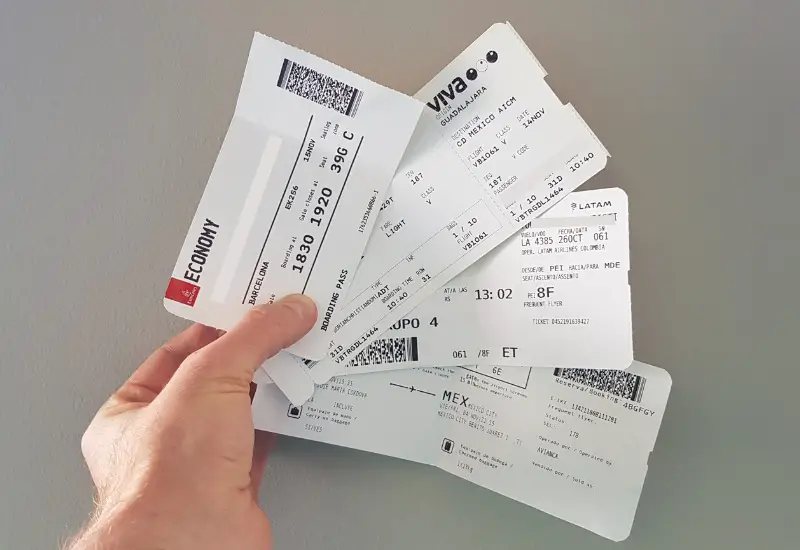Working in the aviation industry comes with its perk and non-rev travel is a big one.
Flying for free or very cheap is possible for flight attendants like me.
How ? That’s what I’ll explain in this article.
What Is Non-Rev Travel?
Non-rev or “non-revenue” travel is one of the main perks that comes with working for an airline.
It basically refers to the flight benefits that pilots, flight attendants, and even some gate agents receive.
It’s called non-reving because the airline does not receive revenue for the employee’s spot on the airplane.
Non-revs are also not guaranteed a spot on the airplane, they have to wait on the standby list and hope that there will be extra space.
Basically, non-revenue travel is the privilege airline employees have to sit in unsold seats and ride along on flights to their desired destinations during their off time.
The best part, they can usually share these benefits with their families, and even a few friends, depending on which airline they work for.
Who Can Non-Rev?
Non-rev benefits are usually given to the airline employee and their direct dependents including:
- Their partner
- Parents
- Children
Some airlines also give their employees a limited number of “buddy passes” that can be given out to friends.
And if you aren’t legally married some airlines will allow you to anyone you choose as your “travel companion” for a set period of time.
⚠️ Not all non-revs are created equal though.
Most airlines have different “pass levels” that determine the order in which non-revs appear on the standby list.
➡️ Generally speaking, the employee, their partner (or travel companion), and their children will all have a higher designation on the standby list, meaning they will have higher priority to get the empty seats on the plane.
➡️ Parents typically come next. And people flying on buddy passes are last.
Can You Fly Standby on All Airlines?
No. But many airlines have agreements with other airlines that allow their employees to non-rev on other airlines.
These airlines usually include whatever code-sharing partners are connected to a given airline but may even include a few airlines outside of their specific airline group.
These agreements are part of a program known as ID90.
Usually, only the employee and their dependents can fly with ID90 partners, and each airline will have different rules about who may non-rev with them and who may not.
🚨 Note: People flying on ID90 benefits will usually fall to the end of the standby priority list.
How Does It Work to Fly Standby as a Non-Rev Traveler?
Generally speaking, each airline has its own online portal that employees can access to arrange their non-rev travel.
Here I’ll quickly run through the basics of flying non-rev.
Booking your Non-rev travel
Usually, you start by going into this portal and selecting the flights you would like to be on.
The portal will usually tell you what the current “load” of each flight is.
Loads refers to the number of revenue passengers who are currently booked to fly on a given flight.
💡 As a non-rev you want to look for flights that have lower loads to increase the likelihood that you will get an open seat.
Signing in for your flight
Then, 24 hours before the flight you sign in via the portal.
At this time, you will be given a standing on the standby list that tells you about the order in which open seats will be assigned to hopeful non-revs.
Some airlines determine this by seniority, so the more senior a flight attendant is with the company, the higher they will be on the standby list.
Other airlines determine this on a first-come-first-serve basis, meaning those who sign in fastest will be at the top of the list. (Depending on pass level).
At the airport
After you have signed in you will arrive at the airport just like you would for any other flight.
Your standby boarding pass will get you through security and then you head to your gate.
👉🏻 At the gate, you should check in with the agent and let them know you are on the standby list.
They will then assign seats in order based on the standby list.
If the flight is full, they will usually do this towards the end of the boarding process, so you just have to hang out and wait to hear your name called.
If the flight is open, they might give you a boarding pass right away.
What happens if there isn’t an open seat?
At this point, you will have the option “roll-over” to the next flight and wait to see if there is an open seat on that one.
Or try to figure out another route to get to where you want to go. If you choose to do this you will be higher on the priority list, for the new flight(s).
Can You Get Non-Rev Loads?
If you have access to the non-rev portal or the ID90 website, you will be able to see the loads for flights you want to non-rev on.
Usually, the portals will tell you how many passengers are booked on each flight, what classes they are booked in, and how many seats are open per cabin. They will also tell you how many non-revs have already indicated an intention to be on that flight.
Not all airlines will share loads with non-employees though, so in that case, the best way to estimate is to look up your flight on the airline’s website and see how many tickets are available to book. This will give you an idea of the number of open seats.
How Much Does it Cost to Non-Rev?
Generally speaking, employees and their dependents will only be charged for international travel, basically to reimburse the airline for international landing taxes.
People flying on buddy passes will often also have to pay a small service charge that amounts to a certain percentage of the ticket price for their flight.
In the US, most employees can non-rev domestically for free.
I’ve traveled both on my own employee benefits, and now as a buddy pass non-rev.
Flying from the US to Germany I paid $130 round trip, for premium economy as an employee, since that was what the international taxes amounted to.
As a buddy pass non-rev, I paid $675 round trip, with a business class seat on one flight and a premium economy seat on the other.
Put simply the savings are significant.
When you fly as an ID90 passenger you will pay more than you do when you fly on your own airline.
Pros of Non-Rev Travel
The benefits of non-rev travel are clear!
It’s cheap and very flexible.
Cons of Non-Rev Travel
The cons are a little less clear until you’ve tried it a few times, but they generally include:
- Scrambling to find another way to get to your destination, sometimes by employing coming up with some very creative, multi-stop routes.
For example, I once flew from Charlotte NC to Harrisburg PA, to get to Chicago IL. - Not getting a seat and having to delay or cancel your trip.
- Waiting at the airport all day just to get a spot on the flight you need to get home.
The first time my parents non-reved it was to my flight attendant training graduation ceremony. They ended up stuck at DFW (Dallas Fort Worth) for 10 hours waiting to get a flight back to Charlotte.
On the flip side, they also enjoyed business class seats on the way to Germany, Hawaii, and Alaska. So, I think they got the most out of my benefits while I had them.
Wrap Up
Non-revenue travel is one of the main benefits of being a flight attendant, but the system can be complicated and hard to navigate at first.
Once you get a handle of how it works, you’ll be sure to be jet setting off to all the places you dreamed of going when you decided to work for an airline.
Have you flown yourself with non-rev travel? How do you find it? Let me in the comments.




